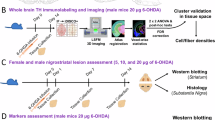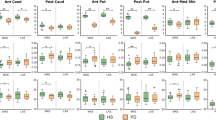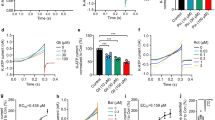Abstract
The function of ATP-sensitive potassium (KATP) channels in nigrostriatal pathway in Parkinson's disease (PD) was studied by employing a novel KATP channel opener iptakalim (Ipt). Apomorphine-induced rotation behavior test and microdialysis experiment were carried out in unilateral 6-hydroxydopamine (6-OHDA) lesioned rats. Behavior test showed that systemic administration of Ipt failed to significantly alleviate apomorphine-induced rotation in unilateral 6-OHDA-lesioned PD model rats. However, using in vivo microdialysis in this PD model rats, it was found that Ipt could increase extracellular dopamine levels in the lesioned side of the striatum and decrease dopamine levels in the intact side of the striatum. Meanwhile, Ipt had no influence on glutamate levels in the intact side, but it did decrease glutamate levels in the lesioned side of the striatum of PD rats. Additionally, in primary cultured rat astrocytes, 6-OHDA decreased overall glutamate uptake activity, but this decrease was recovered and glutamate uptake activity was restored by the opening of KATP channels induced by Ipt and pinacidil. The classical KATP channel blocker glibenclamide completely abolished the effects of Ipt and pinacidil. The present study suggests that (i) the function of KATP channels in the lesioned and intact nigrostriatal pathway is different in unilateral 6-OHDA-lesioned PD model rats. (ii) KATP channels regulate extracellular neurotransmitter levels in the striatum of unilateral 6-OHDA-lesioned rats and may play neuroprotective roles due to their effects on glutamate transporters.
Similar content being viewed by others
Log in or create a free account to read this content
Gain free access to this article, as well as selected content from this journal and more on nature.com
or
References
Anderson CM, Swanson RA (2000). Astrocyte glutamate transporter: review of properties, regulation, and physiological functions. Glia 32: 1–14.
Avshalumov MV, Chen BT, Marshall SP, Penã DM, Rice ME (2003). Glutamate-dependent inhibition of dopamine release in striatum is mediated by a new diffusible messenger, H2O2 . J Neurosci 23: 2744–2750.
Avshalumov MV, Rice ME (2004). Activation of ATP-sensitive K_ (KATP) channels by H2O2 underlies glutamate-dependent inhibition of striatal dopamine release. PNAS 100: 11729–11734.
Betarbet RB, Sherer JT, Greenamyre J (2002). Animal models of Parkinson's disease. Bioessays 24: 308–318.
Blandini GF, Nappi C, Tassorelli E, Martignoni E (2000). Functional changes of the basal ganglia circuitry in Parkinson's disease. Prog Neurobiol 62: 63–88.
Brockhaus J, Deitmer JW (2000). Developmental downregulation of ATP-sensitive potassium conductance in astrocytes in situ. Glia 32: 205–213.
Calabresi P, Mercuri NB, Sancesario G, Bernardi G (1993). Electrophysiology of dopamine-denervated striatal neurons: Implications for Parkinson's disease. Brain 116: 433–452.
Cao F, Sun SG, Tong ET, Luo F (2003). Experimental study on the behavioral effects on rats with Parkinson's disease by different dose of Levodopa. J Apoplexy Nerv Dis 20: 14–16.
Carman LS, Gage FH, Shults CW (1991). Partial lesion of the substantia nigra: relation between extent of lesion and rotational behavior. Brain Res 553: 275–283.
Davis KE, Straff DJ, Weinstein EA, Bannerman PG, Correale DM, Rothstein JD et al (1998). Multiple signaling pathways regulate cell surface expression and activity of the excitatory amino acid carrier 1 subtype of Glu transporter in C6 glioma. J Neurosci 18: 2475–2485.
Dowd LA, Robinson MB (1996). Rapid stimulation of EAAC1-mediated Nacl-dependent L-glutamate transporter activity in C6 glioma by phorbol ester. J Neurochem 67: 508–516.
Dunn-Meynell AA, Rawson NE, Levin BE (1998). Distribution and phenotype of neurons containing the ATP sensitive potassium channel in rat brain. Brain Res 814: 41–54.
Ferrarese C, Begni B, Canevari C, Zoia C, Piolti R, Frigo M et al (2000). Glutamate uptake is decreased in platelets from Alzheimer's disease patients. Ann Neurol 47: 641–643.
Frizzo ME, Lara DR, Dahm KC, Prokopiuk AS, Swanson RA, Souza DO (2001). Activation of glutamate uptake by guanosine in primary astrocyte cultures. Neuroreport 12: 879–881.
Greif GJ, Lin YJ, Liu JC, Freedman JE (1995). Dopamine-modulated potassium channels on rat striatal neurons: specific activation and cellular expression. J Neurosci 15: 4533–4544.
Hazell AS, Itzhak Y, Liu H, Norenberg MD (1997). 1-Methyl-4-phenyl-1,2,3,6-tetrahydropurikine (MPTP) decreases glutamate uptake in cultured astrocytes. J Neurochem 68: 2216–2219.
Jonkers N, Sarre S, Ebinger G, Michotte Y (2002). MK801 suppresses the L-DOPA-induced increase of glutamate in striatum of hemi-Parkinson rats. Brain Res 926: 149–155.
Kis B, Rajapakse NC, Snipes JA, Nagy K, Horiguchi T, Busija DW (2003). Diazoxide induces delayed pre-conditioning in cultured rat cortical neurons. J Neurochem 87: 969–980.
Lee K, Dixon AK, Rowe IC, Ashford ML, Richardson PJ (1996). The high-affinity sulphonylurea receptor regulates KATP channels in nerve terminals of the rat motor cortex. J Neurochem 66: 2562–2571.
Levesque D, Greenfield SA (1991). Psychopharmacological evidence for a role of the ATP-sensitive potassium channel in the substantia nigra of the rat. Neuropharmacology 30: 359–365.
Madl JE, Burgesser K (1993). Adenosine triphosphate depletion reverses sodium-dependent, neuronal uptake of glutamate in rat hippocampal slices. J Neurosci 13: 4429–4444.
Maneuf YP, Duty S, Hille CJ, Crossman AR, Brotchie JM (1996). Modulation of GABA transmission by diazoxide and cromakalim in the globus pallidus: implications for the treatment of Parkinson's disease. Exp Neurol 139: 12–16.
Matute C, Alberdi E, Ibarretxe G (2002). Excitotoxicity in glial cells. Eur J Pharmacol 447: 239–246.
Meng CH, Ding JH, He HH, YANG Y, Hu G (2003). Relationship between neurotoxicity of 6-hydroxydopamine and glutamate transporter. Acta Pharmaceutica Sinica 38: 885–888.
Meshul CK, Emre N, Nakamura CM, Allen C, Donohue MK, Buckman JF (1999). Time-dependent changes in striatal glutamate synapses following a 6-hydroxydopamine lesion. Neuroscience 88: 1–16.
McGroarty A, Greenfield SA (1996). Blockade of dopamine storage, but not of dopamine synthesis, prevents activation of tolbutamide-sensitive Kq channel in the guinea-pig substantia nigra. Exp Brain Res 110: 360–366.
Mourre C, Widmann C, Lazdunski M (1990). Sulfonylureas binding sites associated with ATP-regulated Kq channels in the nervous system: autoradiographic analysis of their distribution and ontogenesis, and of their localization in mutant mice cerebellum. Brain Res 519: 29–43.
Murer MG, Dziewczapolski G, Menalled LB, Garcia MC, Agid Y, Gershanik O et al (1998). Chronic levodopa is not toxic for remaining dopamine neurons, but instead promotes their recovery, in rats with moderate nigrostriatal lesions. Ann Neurol 43: 561–575.
Neusch C, Runde D, Moser A (2000). G proteins modulate D2 receptor-coupled K(ATP) channels in rat DArgic terminals. Neurochem Res 25: 1521–1526.
Nutt GJ, Hloford NH (1996). The response to levodopa in Parkinson's disease: imposing pharmacological law and order. Ann Neurol 39: 561–573.
Paxinos G, Watson C (1986). The Rat Brain in Stereotaxic Coordinates, 2nd edn. Academic Press: San Diego.
Perese DA, Ulman J, Viola J, Ewing SE, Bankiewicz KS (1989). A 6-hydroxydopamine-induced selective Parkinsonian rat model. Brain Res 494: 285–293.
Pines G, Kanner BI (1990). Counterflow of 1-glutamate in plasma membrane vesicles and reconstituted preparations from rat brain. Biochemistry 29: 11209–11214.
Roeper J, Hainsworth AH, Ashcroft FM (1990). Tolbutamide reverses membrane hyperpolarisation induced by activation of D receptors 2 and GABA receptors in isolated substantia nigra neurons. Pflugers B Arch 416: 473–475.
Ronald D, Arjan B, Jos P (2002). Modeling Parkinson's disease in rats: an evaluation of 6-OHDA lesions of the nigrostriatal pathway. Exp Neurol 175: 303–317.
Tolwani RJ, Jakowec MW, Petzinger GM, Green S, Waggie K (1999). Experimental models of Parkinson's disease: insights from many models. Lab Anim Sci 49: 363–371.
Wang H (2003). Pharmacological characteristics of the novel antihypertensive drug, iptakalim hydrochloride, and its molecular mechanisms. Drug Dev Res 58: 65–68.
Wang H, Zhang YL, Tang XC, Feng HS, Hu G (2004). Targeting ischemic stroke with a novel opener of ATP-sensitive potassium channels in the brain. Mol Pharmacol 66: 1160–1168.
Wang S, Hu LF, Yang Y, Ding JH, Hu G (2005). Studies of ATP-sensitive potassium channels on 6-hydroxydopamine and haloperidol rat models of Parkinson's disease: implications for treating Parkinson's disease? Neuropharmacology 48: 984–992.
Yang Y, Liu X, Ding JJ, Sun J, Long Y, Wang F et al (2004). Effects of iptakalim on rotenone-induced cytotoxicity and dopamine release from PC12 cells. Neurosci Lett 366: 53–57.
Yang Y, Liu X, Long Y, Wang F, Ding JH, Liu SY et al (2005). Systematic administration of iptakalim, an ATP-sensitive potassium channel opener, prevents rotenone-induced motor and neurochemical alterations in rats. J Neurosci Res 80: 442–449.
Yao HH, Ding JH, Zhou F, Wang F, Hu LF, Sun T et al (2005). Enhancement of glutamate uptake mediates the neuroprotection exerted by activating group II or III metabotropic glutamate receptors on astrocytes. J Neurochem 92: 948–961.
Vandenberg RJ (1998). Molecular pharmacology and physiology of glutamate transporters in the central nervous system. Clin Exp Pharmacol Physiol 25: 393–400.
Zhang Y, Ding JH, Hu G (2004). SIB-1893 reversed 6-OHDA-induced inhibitory effect on glutamate uptake of astrocytes. Chin J Clin Pharmacol Ther 9: 25–28.
Zhou M, Tanaka O, Suzuki M, Sekiguchi M, Takata K, Kawahara K et al (2002). Localization of pore-forming subunit of the ATP-sensitive K(+)-channel, Kir6.2, in rat brain neurons and glial cells. Brain Res Mol Brain Res 101: 23–32.
Zhu DX, Sullivan JP, Brioni JD (1999). ATP-sensitive potassium channels regulate in vivo DA release in rat brain. Jpn J Pharm 79: 59–64.
Acknowledgements
The research was supported in part by grants from the National Natural Science Foundation of China (No. 39970846), the Key Project of Jiangsu Health Department (No. K200501), the Key Project of Natural Science Foundation of Jiangsu Educational Council and Specialized Research Fund for the Doctoral Program of Higher Education (No. 20040312004). Dr Kevin Ellsworth, in Barrow Neurological Institute (Phoenix AZ, USA), helped to correct English writing.
Author information
Authors and Affiliations
Corresponding author
Rights and permissions
About this article
Cite this article
Wang, S., Hu, Lf., Zhang, Y. et al. Effects of Systemic Administration of Iptakalim on Extracellular Neurotransmitter Levels in the Striatum of Unilateral 6-Hydroxydopamine-Lesioned Rats. Neuropsychopharmacol 31, 933–940 (2006). https://doi.org/10.1038/sj.npp.1300857
Received:
Revised:
Accepted:
Published:
Issue date:
DOI: https://doi.org/10.1038/sj.npp.1300857
Keywords
This article is cited by
-
Telmisartan Ameliorates Astroglial and Dopaminergic Functions in a Mouse Model of Chronic Parkinsonism
Neurotoxicity Research (2018)
-
Potassium Channel in the Mitochondria of Human Keratinocytes
Journal of Investigative Dermatology (2014)
-
Reversal of Rotenone-Induced Dysfunction of Astrocytic Connexin43 by Opening Mitochondrial ATP-Sensitive Potassium Channels
Cellular and Molecular Neurobiology (2011)
-
Excitotoxicity in Rat’s Brain Induced by Exposure of Manganese and Neuroprotective Effects of Pinacidil and Nimodipine
Biological Trace Element Research (2009)
-
KATP Channel Openers Facilitate Glutamate Uptake by GluTs in Rat Primary Cultured Astrocytes
Neuropsychopharmacology (2008)



